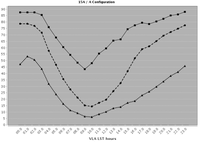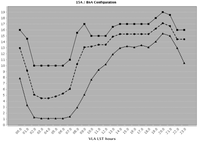Very Large Array (VLA) Proposals
VLA Configuration Plans and Science Time Available
The 1 August 2014 deadline covers the observing period 6 February 2015 through 21 September 2015 (Semester 2015A), corresponding to the B, BnA and A configurations. Multi-configuration proposals that include B, BnA and/or A configurations may also be submitted. In addition, proposals requesting only configurations that will fall in semester 2015B or later may be submitted, if the Principal Investigator is a graduate student. NRAO offers this service to provide scientific and technical feedback for students, and to provide them with an opportunity to re-submit their proposals for their principal semester with this information in hand. Students should ensure that their status is up-to-date and correct in the NRAO User Database. Please refer to the VLA Configuration Plans and the plots of estimated available observing hours as a function of LST and weather conditions for all configurations in the upcoming semester, below. In these plots, engineering, maintenance, and testing cause the thick black line to be less than the total number of LST days in the configuration. Such activities occur predominantly during daytime.
Observing Capabilities for Semester 2015A
Enhanced capabilities offered for 2015A include the transition of P-band Stokes I observing, dump times as short as 50 msec, and recirculation up to a factor of 4 to our General Observing (GO) program. In addition, observing with the On The Fly (OTF) mosaicing mode, 32 sub-bands per baseband with the 8-bit samplers, recirculation up to a factor of 64, and 8-stream recording for VLBA observations with the phased VLA have been moved from our Resident Shared Risk Observing (RSRO) program to our Shared Risk Observing (SRO) program. Details of the general capabilities are given in the VLA Observational Status Summary (OSS), and are summarized below.
| Capability | Description |
|---|---|
|
8-bit samplers |
Standard default set-ups for:
Flexible set-ups for spectroscopy, using two independently tunable 1 GHz basebands, each of which can be split into up to 16 flexibly tunable sub-bands Single, dual, and full polarization products Number of channels summed over all polarization products up to 16,384 (no recirculation) or up to 65,536 (with recirculation) |
|
3-bit samplers |
Standard default set-ups for:
Flexible set-ups for spectroscopy, using four independently tunable 2 GHz basebands, each of which can be split into up to 16 flexibly tunable sub-bands Single, dual, and full polarization products Number of channels summed over all polarization products up to 16,384 (no recirculation) or up to 65,536 (with recirculation) |
|
Mixed 3-bit and 8-bit samplers |
Allows more flexibility for simultaneous continuum and high-resolution spectral line observing |
|
Sub-arrays |
Up to 3 independent sub-arrays using standard 8-bit continuum set-ups |
|
Phased array for VLBI |
See VLBA-HSA-VLBI section of this Call for Proposals |
Both single pointing and mosaics with discrete, multiple, field centers will be supported. Data rates up to 25 MB/s (90 GB/hour) will be available to all users, and with additional justification, data rates up to 60 MB/s (216 GB/hour) will be available. Correlator integration time limits per band and per configuration also apply, as described in the OSS. The data rate and total data volume required by a proposal will be a consideration in its technical evaluation.
There are some limitations on frequency settings and tuning ranges, please consult the OSS for further details. In addition, special tools are available to assist users with the development of correlator set-ups for the proposal deadline (see VLA Proposal Preparation and Submission), and the Exposure Calculator has been updated. All antennas employ electronics and receiver systems that provide continuous frequency coverage from 1-50 GHz in the following observing bands: 1-2 GHz (L-band); 2-4 GHz (S-band); 4-8 GHz (C); 8-12 GHz (X); 12-18 GHz (Ku); 18-26.5 GHz (K); 26.5-40 GHz (Ka); and 40-50 GHz (Q).
We will continue to offer shared risk programs to our user community for those who would like to push the capabilities of the VLA beyond those offered for general use:
VLA Shared Risk Observing
The VLA Shared Risk Observing (SRO) program allows users access to capabilities that can be set up via the OPT and run through the dynamic scheduler (without intervention), but are not well tested. The following capabilities are offered under the SRO program in Semester 2015A:
- On-the-Fly (OTF) mosaicing
- 32 sub-bands per baseband with the 8-bit samplers
- recirculation of up to a factor of 64
- 8-stream recording with phased VLA for VLBA observing.
See the VLA Proposal Preparation and Submission web page for information about tools and other advice on proposing for Shared Risk observing capabilities.
VLA Resident Shared Risk Observing
The VLA Resident Shared Risk Observing (RSRO) program provides access to extended capabilities of the VLA that require additional testing, in exchange for a period of residence to help commission those capabilities. Capabilities that would fall under the RSRO program in Semester 2015A include, e.g.,
- correlator dump times shorter than 50 msec, including integration times as short as 5 msec for transient detection
- pulsar observations
- data rates above 60 MB/s
- recirculation beyond a factor of 64 in the correlator
- P-band system polarimetry and spectroscopy
- more than 3 sub-arrays or sub-arrays with the 3-bit system, and
- complex phased array observations (e.g., pulsar and complex VLBI observing modes).
A detailed description of the VLA RSRO program for semester 2015A and beyond is available at the VLA Proposal Preparation and Submission web page.
Low Frequency Observing
The new low frequency receiver system developed in collaboration with the Naval Research Laboratory will be available for Stokes I continuum observations at P-band (230 to 470 MHz), through the General Observing program. Use of the P-band system for polarimetry and/or spectroscopy will be through the Resident Shared Risk Observing Program. The new receivers also work at 4-band (54 to 86 MHz), and a new feed compatible with the EVLA electronics is being developed, but is not yet commissioned. Members of the community interested in helping to commission the 4-band system in return for early access to this system via peer-reviewed telescope time should apply through the RSRO program described above. We expect at least 6 antennas to be outfitted with 4-band receivers for Semester 2015A.
Proposal and Observation Preparation
Proposal preparation and submission are via the Proposal Submission Tool (PST) at NRAO Interactive Services. Use of the PST requires registration in the NRAO User Database. There are various tools and documentation to help users in this process. Descriptions of all updated documentation and tools along with an outline of the steps required to write a proposal are available at the VLA Proposal Preparation and Submission web page.
When constructing sessions in the PST, proposers should be cognizant of their use by the Time Allocation Committee (TAC). Specifically, taking into account the time available as a function of LST, the TAC will assign a scheduling priority to each session in each proposal. The assigned scheduling priority will depend on the linear-rank score of the proposal, the LSTs involved in the session (daytime is harder to accommodate than nighttime), the total time requested in the session, and the competition from better-ranked proposals requesting time at similar LSTs. Please see the description of the VLA prioritizer for further details.
All approved VLA observations are set up using the Observation Preparation Tool (OPT). Most, if not all, projects will be observed dynamically so users should submit scheduling blocks early in the configuration to maximize the opportunity of them being observed. Advice on the optimal length of scheduling blocks and other useful information may be found at the Observing FAQ web page.
Information about VLA capabilities, observing strategies, and calibration overhead can be found in the VLA Observational Status Summary, at the Guide to Observing with the VLA, and at the Observing FAQ web page. Questions may also be directed to the NRAO Helpdesk.







Connect with NRAO